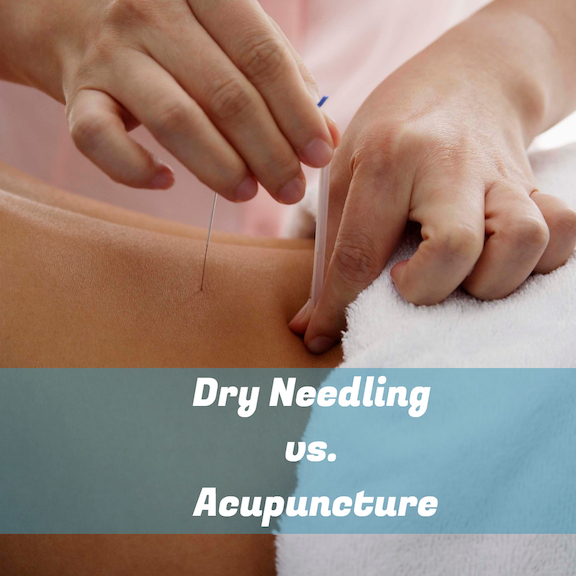Dry needling versus acupuncture is a hot topic of debate amongst professionals in the fields of acupuncture and physical therapy for some time now. Although it may look very similar if you were to look at a photo of the two, being that they both essentially use the same type of filiform needle, there have very different qualities and practices.
Understanding & recognizing the differences can help you decide which type of treatment is right for you. Everything from the type of needling to the points used in the treatment of pain are different from dry needling to acupuncture. Dry needling is a much newer technique, and acupuncture is thousands of years old with licensed professionals. It is easy to see why dry needling is such a controversial topic amongst professionals in the field.
Dry Needling
What is it?
Dry needling is a much more modern technique (think a few decades) using hair thin filiform acupuncture needles to treat chronic pain. Intra-Muscular Stimulation (IMS), also known as Trigger Point Dry Needling or fenestration (the medical term for dry needling), was developed in the late 1970’s by Dr. Chan Gunn, a Canadian western trained physician who combined western medicine and acupuncture to develop IMS.
The most common form of dry needling is by inserting the needle into the point of pain in the muscle and leaving it in for 10-30 minutes depending on the practitioner.
However, there are two other types of dry needling that are utilized:
- Non-trigger points – with this technique, the provider inserts the needles into the surrounding muscle where the pain is instead of directly in the knotted or contracted muscle/pressure point. It relies on the idea that pain is the result of a greater muscular or nerve issue, not just the main area of pain.
- In and out – also known as “pistoning” or “sparrow pecking” or “dynamic needling,” with this technique, the provider inserts the filiform needle into a trigger point and removes it immediately.
Essentially, dry needling targets and manipulates the area of pain in question in order to relieve negative pain sensations. For instance, if an athlete’s leg has been injured with the muscle painfully knotted, a practitioner will insert the needle into this point to get the muscle to relax. Dry needling is supposed to change the body’s ability to perform activities, improve movement quality, and lessen pain. Sports therapists, other physical therapists, chiropractors, and massage therapists are typically the ones who perform dry needling.
Here are some concerns with dry needling:
- No credentialing board
- No state licensure required
- No formal training required
- No guidelines
Unlike acupuncture, dry needling does not require extensive education, training, or regulation of any kind at this point in time. Some form of licensure & standardization will be required as more research is developed on this modality, but as of now, there are no guidelines for practice. Depending on the state, the certification for dry needling totals around 46 hours of training including overall patient safety, safe needle techniques, contraindications, and indications.
Acupuncture
The practices of acupuncture are extensive and rooted in ancient Chinese & Eastern medicine to help the patient achieve homeostasis and healing within the body. The various acupuncture points along the meridians of the body all relate to specific spiritual, physical, and emotional dysfunctions which is why acupuncture can treat many conditions outside of the musculoskeletal system.
Common health conditions that acupuncture can help with are:
- Back pain
- Anxiety/Depression
- The common cold
- Arthritis
- Nausea/Vomiting
- Fertility
- Allergies
- Headaches
- Addiction
- Smoking Cessation
The World Health Organization recognizes acupuncture as effective in treating hundreds of diseases & symptoms, and The American Medical Association accepts acupuncture as a medical treatment.
The foundational belief of acupuncture is that illness results from blocked or stagnated qi (pronounced “chee”). Qi normally provides the body with healing energy. Acupuncture removes these blockages to restore balance and energy flow in the body. The treatment may also involve electrical stimulation or the application of heat or pressure.
At this time, acupuncture has more definitive research on treatment results as well as extensive regulations on the training and licensing of acupuncture providers.
An acupuncturist must meet the following requirements before needling a patient:
- Future acupuncturists must attend a school accredited by the Accreditation Commission for Acupuncture and Oriental Medicine (ACAOM) which is recognized by the US Department of Education as the authority in this field.
- They must complete at least two years at the baccalaureate level, and many schools require a bachelor’s degree.
- They must complete a master’s level program in acupuncture or acupuncture & oriental medicine at an ACAOM accredited school whose program can range anywhere from three to four years including an internship.
- They must undergo testing from the National Certification Commission for Acupuncture and Oriental Medicine (NCCAOM), and take continuing education courses each year to maintain their license.
During their education, a licensed acupuncturist will have also taken a mid-curriculum exam demonstrating their knowledge of both the pathophysiology of the body & the philosophy of medicine. Additionally, within their program their training also includes proper treatment diagnosis, planning and the use of needles along with having direct supervision from another senior or expert practitioner. Basically, when all is said and done, licensed acupuncturists earning a master’s degree will have a total of 1,905 – 2,625 hours of education and training.
Acupuncture & Dry Needling Practices
Although these two practices use the same hair-thin filiform needles & insert them into the skin, the methods in which they insert the needles are completely different.
Acupuncture treatment:
- Acupuncturists don’t rely on pain areas for effective treatment, but instead use specific acupuncture points that lie on meridian channels of the body to target health concerns. Acupuncture also utilizes the response of the nervous system to stimulate it, and get the blood & qi moving.
- Acupuncture needles range in length from 7mm to 150mm with gauges ranging from 0.18mm to 0.30mm
- The typical depth of penetration is 3mm to 10mm, and often not at the exact pain site & left in for longer periods of time than dry needling.
Dry Needling treatment:
- Needles are inserted directly into the trigger point or muscle that is irritable or knotted to stimulate it & relieve pain and/or spasms. It is said to improve flexibility and increase range of motion.
- There are some needles that are marketed for dry needling that are made with high-grade German steel, but most providers use the same needles as licensed acupuncturists.
- 0.30mm x 50mm is said to be usually appropriate for most muscles (.30mm being the gauge and the 50mm being the length). There are also needles that are 60mm, 75mm, and even all the way up to 100mm long as well as smaller needles for smaller muscles like in the forearm & face/hand that are .14mm x 25mm & .12mm x 25mm. The depth usually can go as deep as 12.3mm depending on the muscle. The needle used as well as the depth is at the discretion of the provider.
Depending on the issue you are seeking care for, the technique used is also something to consider when looking for a provider.
Acupuncture or Dry Needling
Which is better?
If you are weighing the options between acupuncture & dry needling, it very well may come down to a matter of preference and what you feel more comfortable with. Dry needling is not as well of an established alternative treatment, compared to acupuncture.
Furthermore, dry needling does not have extensive research behind it. One research study in 2017 took 27 participants to try and determine the effects of dry needling on hamstring extensibility & functional performance. It concluded that dry needling did not increase extensibility any more than that of stretching alone & may improve certain dimensions of functional performance, but no clear conclusion can be made. Another study done in 2012 involved 39 participants with rotator cuff disease and compared dry needling treatment with platelet-rich plasma injections. This study demonstrated dry needling to be less effective than the plasma injections in reduction of pain and disability.
Alternatively, there is a plethora of research conducted on acupuncture past and present to evaluate its benefits, not only in the realm of pain, but for many other conditions. Various studies also show acupuncture’s positive effect on the brain. In 2009 a study showed a surge in opioid receptors during & long after treatment, and most recently in 2019 with a compendium of research defining the pathways & neural circuitry giving a solid foundation for acupuncture clinical efficiency.
The fact of the matter is that dry needling technique brings up a few concerns, one of them being the limited research available on it and minimal provider training. The lack of time and consistency in training, certification, or licensure regulations for dry needling can be a cause for concern in terms of experience of the provider and safety for the patient. Since there is no credentialing board, it is difficult to determine if a providers training is satisfactory.
If you should choose dry needling, be sure to find a provider with a postgraduate healthcare education as well as a provider who uses ultrasound-guided dry needling to ensure accuracy.
For a well-established alternative treatment with the research to back it, licensed acupuncturists who have a masters or doctorate degree with thousands of hours of training & hands on experience, acupuncture is the top choice.

Acupuncture Near Me
Get acupuncture near you today with Best Acupuncture Near Me, and contact a local acupuncture practitioner to find out if acupuncture is right for you.

